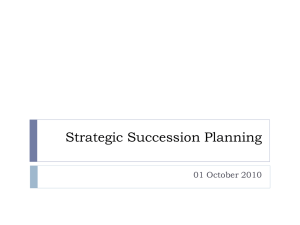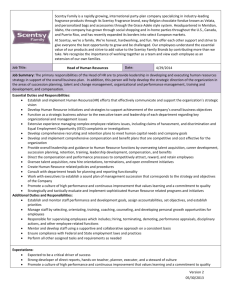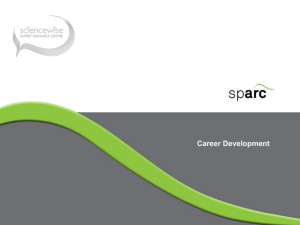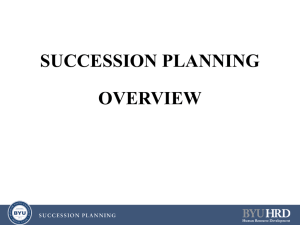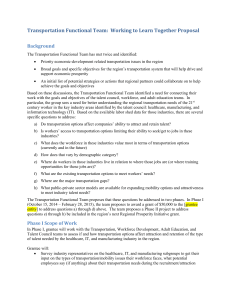Succession Planning - Florida International University
advertisement
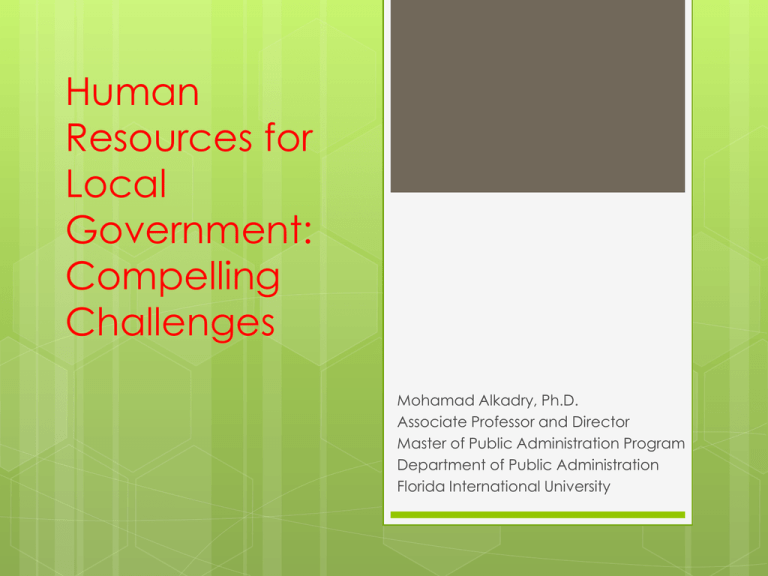
Human Resources for Local Government: Compelling Challenges Mohamad Alkadry, Ph.D. Associate Professor and Director Master of Public Administration Program Department of Public Administration Florida International University Agenda Local Vs. Federal (National/Central) in the United States Key Challenges Aging Workforce and Succession Planning Accommodating the Female Talent Competing for Talent Local Vs. State & Federal Distribution of Government Workers in the US – 2011 UNIVERSE: 22 Million Workers Federal 13% State government 23% Local government 64% Distribution of Government Workers in the US – 2011 UNIVERSE: 22 Million Workers Local government, excluding education 28% Local government education 36% Federal, except U.S. Postal Service 10% U.S. Postal State Service government 3% education 11% State government, excluding education 12% Federal Vs. State Powers Federal Only Print money Declare war Establish army & navy Enter into treaties with foreign governments Regulate commerce Establish post offices & issue postage State Only Establish local governments Issue licenses Regulate intrastate commerce Conduct elections Ratify Constitution amendments Public health and safety Shared Powers Setting up courts Creating and collecting taxes Building highways Borrowing money Making & enforcing laws Chartering banks & corporations Spending money Imminent Domain Human Resources In the United States, local and regional governments can hire a workforce that matches community needs and budget constraints Hiring and firing government workers in service sectors Filling open positions as needed Setting the job qualifications Determining salary levels and supplement salaries on a performance basis Determine the number of positions of government employees at the local level. Education of Employees 100% 9.4 7.2 Post Grad 14.5 90% 80% 70% 18.9 9.4 17.7 50% 19.9 30% 26 Assoc Degree 24 9.8 22.6 30 31.6 26.2 11.5 Some College 40% 20.8 Bachelor's Degree 9.3 60% 19.6 25.2 9.7 16.2 19.4 High School 20% 10% 12.7 14.3 0% Total Private < High School 22.7 18.5 22.3 2.8 3.1 4.7 PA: Federal PA: State PA: Local The Aging Workforce and Succession Planning Age Distribution 100% 90% 25.8 23.9 38.9 80% 34.2 36.1 50+ 70% 60% 24.6 24.1 40-49 25.8 50% 27.4 30.1 40% 22.4 22.6 30-39 20.9 30% 20% 10% 27.2 29.4 <30 21.9 19.4 11.6 19.2 14.6 0% Total Private PA: Federal PA: State PA: Local Succession Planning Assessment of Key Positions Identification of Key Talent Key Elements Development Monitoring & Review Assessment of Key Talent Generation of Development Plans Source: BYU HRD Succession Planning 1. Assessment of Key Positions: • What are the competencies and experiences needed to qualify for each key position? 2. Identification of Key Talent: • Identified by their management’s assessment of their performance and potential for advancement. 3. Assessment of Key Talent: • For each person on the radar screen, primary development needs are identified focusing on what they need in order to be ready for the next level. Source: BYU HRD Succession Planning 4. Generation of Development Plans: • A development plan is prepared for how we will help the person develop over the next year. 5. Development Monitoring & Review • An annual or semi-annual succession planning review is held to review progress of key talent and to refresh or revise their development plan. Source: BYU HRD Challenges Sophisticated Human Resources process of identifying future need, identifying new talent and preparing the new talent for future need Correlation between HR Department size and local government size $$$ vary by local government – Fellowship Programs, professional development Pool varies by local government Fluid Workforce Centralization Vs. Decentralization Recruiting Female Talent Figure 2.3. Percentage of 25-29 year-olds who attained University Degrees (1971–2009) Male (Bachelor) Female (Bachelor) Male (Masters) Female (Masters) 35 35 27 27 8.7 8.8 33 32 32 25 25 30 28 25 24 23 21 21 20 25 24 24 23 26 19 14 4.1 4.9 1971 1975 1980 1985 1990 1995 6.2 4.7 2000 7.3 7.8 7.6 5.1 2005 5.1 2006 5.0 2007 5.3 2008 6.1 2009 Challenges Women continue to occupy lower positions in local government at higher proportion Women continue to be segregated in certain agencies but not others Women continue to be segregated in certain occupations Challenge: How do we make all local government jobs, at all levels, and in all departments competitive to women? Women Representation in State and Local Governments 73% 73% HEALTH 27% 25% UTILITIES & TRANSPORTATION 19% 21% STREETS AND HIGHWAYS % Women New Hires 19% 17% SANITATION & SEWAGE 78% 78% PUBLIC WELFARE 33% 29% POLICE PROTECTION NATURAL RESOURCES 35% 47% 75% 74% HOSPITALS & SANATORIUMS 11% 9% FIRE PROTECTION 63% 63% EMPLOYMENT SECURITY 42% 39% CORRECTIONS 0% 10% 20% 30% 40% 50% 60% 70% 80% 90% Competing for Talent Regional Inequalities in human resources based on size of municipality and ability to pay competitive wages Smaller units of government have less opportunity to build expertise – employees often perform multiple jobs in small municipalities




